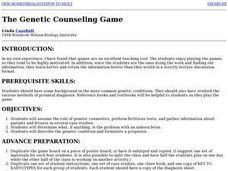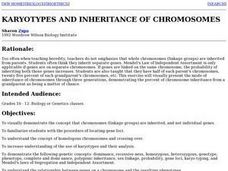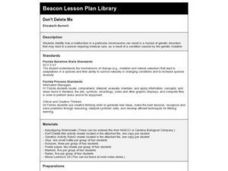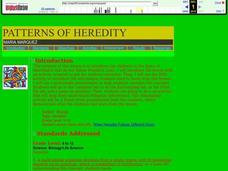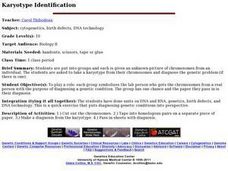Curated OER
Genetic Variation Worksheet
Fill- in-the-blank, labeling, and short answer questions make up this well-written cell division worksheet. Neat diagrams of chromosomes and dividing cells are included. Junior biologists show what they know about reproduction, meiosis,...
Virginia Department of Education
Genetic Variation and Mutations
Young scientists demonstrate their creativity while completing several activities, to assess genetic variations and mutations. Instructors provide a list of options and scientists choose to write a comic strip, create a book,...
Curated OER
Genetic Disorders
Students examine how living cells create new cells and how genetic mutations can cause disorders and be inherited. In this genetic reproductionn lesson students create their own PowerPoint presentation.
Curated OER
Lesson 10: Karyotypes
Students predict traits of future offspring. In this biology instructional activity, students study karyotyping to predict genetic disorders. They research an assigned karyotype and present information about it.
K20 LEARN
You're My 'Karyo'-Type: Karyotype For Chromosomal Disorders
What's your type? Genetically speaking, of course! Immerse your class in the world of karyotypes through an insightful activity from the K20 Center. Scholars take on the role of genetic counselors to determine the karyotype of offspring...
Curated OER
Jurassic Park: The Science and Ethics of Genetic Engineering
Explore genetic engineering through an engaging "Jurassic Park" unit, which is an extensive use of a cross-curricular teaching event. Planned for AP Biology, English, and Calculus students, learners and teachers are involved for 4-6...
Curated OER
Chromosome Karyotyping
Students explore chromosome karyotyping. In this chromosome karyotyping lesson plan, students use a chromosome kit to explore chromosome syndromes and disorders. They also produce a large model of a cell with chromosome to simulate cell...
Curated OER
KARYOTYPE ALTERNATIVES
Students comprehend that karyotyping is a process in which chromosomes are cut from an enlarged picture and arranged in decreasing order of size. The cells to be viewed are first chemically treated to increase the number of dividing...
Curated OER
The Human Genotype
Six different chromosome activites introduce biology aces to heredity, chromosomal abnormalities, sex-linked traits, and the human genome. The hands-on activites are fairly simple for the teacher to prepare and will prove to be both...
Curated OER
What is the purpose of Karyotyping?
Students explain how karyotyping is used to diagnose specific genetic disorders. They use karyotypes to make observations and analyze chromosomal errors. This activity can be completed online or without computer access.
Curated OER
Genetics 5 Technology
High schoolers, after studying extraction and gel electrophoresis, recombinant DNA, transgenic organisms, and reproductive cloning, summarize the main concepts in DNA technology. They analyze the applications of DNA: forensics, medicine,...
Curated OER
The Genetic Counseling Game
Learners explore genetics and ethical issues. They siimulate the role of genetic counselors, perform fictitious tests, and gather information about parents and fetuses in case studies. Students describe the condition and formulate a...
Curated OER
Karyotype Alternatives
Students study karyotyping, which is a process in which chromosomes are cut out from an enlarged picture and arranged in decreasing order of size. They use a template to arrange and glue chromosomes to data sheet, indicate sample code,...
Curated OER
Reaching Into Your Genes
Young scholars interact with a video to explore the basis for the science of chromosomes. They perform a chromosomal analysis called a karyotype and explore how seemingly minute errors in chromosomes can lead to devastating illnesses.
Biology Corner
A Chromosome Study
Study groups based on sizes of pairs. Pupils use images of chromosomes to create an organized pattern grouped into pairs and organized on size called a karyotype. Scholars create a second karyotype that contains a genetic disorder and...
Curated OER
Karyotype Puzzle
Students identify chromosome pairs based upon band patterns and location of centromere. They order chromosome pairs based upon size. Students differentiate normal karyotypes from abnormal karyotypes. They correctly record karyotype...
Curated OER
Karyotypes and Inheritance of Chromosomes
Students explore the mode of inheritance of chromosomes. Given a scenario, students use the Human Genome sheet to determine inherited chromosomes. They illustrate the difference between genotype and phenotype. Students develop a model...
Curated OER
Human Heredity Vocabulary
Ninth graders review the terms "aneuploidy," "fetus," and "karyotype" in this vocabulary worksheet, which includes three multiple choice questions about each term. This activity could be expanded into a more developed vocabulary lesson...
Curated OER
Don't Delete Me
Fourth graders explore genetic disorders, which can be caused by a malfunction in a particular chromosome and how these can cause genetic mutation.
Curated OER
How Can You Predict the Characteristics of an Unborn Baby?
Learners compare three sets of unlabeled human chromosomes and gather related data, trace chromosomes to pair them, and make observations about them.
Curated OER
Patterns of Heredity
Students describe the differences between incomplete dominance and codominant alleles, and between multiple alleles and polygenic inheritance. They describe how internal and external environments affect gene expression. They then...
Curated OER
Karyotypes & Chromosome Inheritance
Young scholars study Mendelian genetic terms, locate and name loci on chromosomes, karyotype construction, inheritance patterns through families.
Curated OER
Karyotype Identification
Tenth graders lake a karyotype from their chromosomes and diagnose the genetic problem (if there is one).
Curated OER
Genetics 4 Mutations
Students identify and illustrate how changes in DNA cause mutations and evaluate the significance of these changes. They illustrate a chromosomal mutation such as duplication, deletion, inversion, and translocation.













